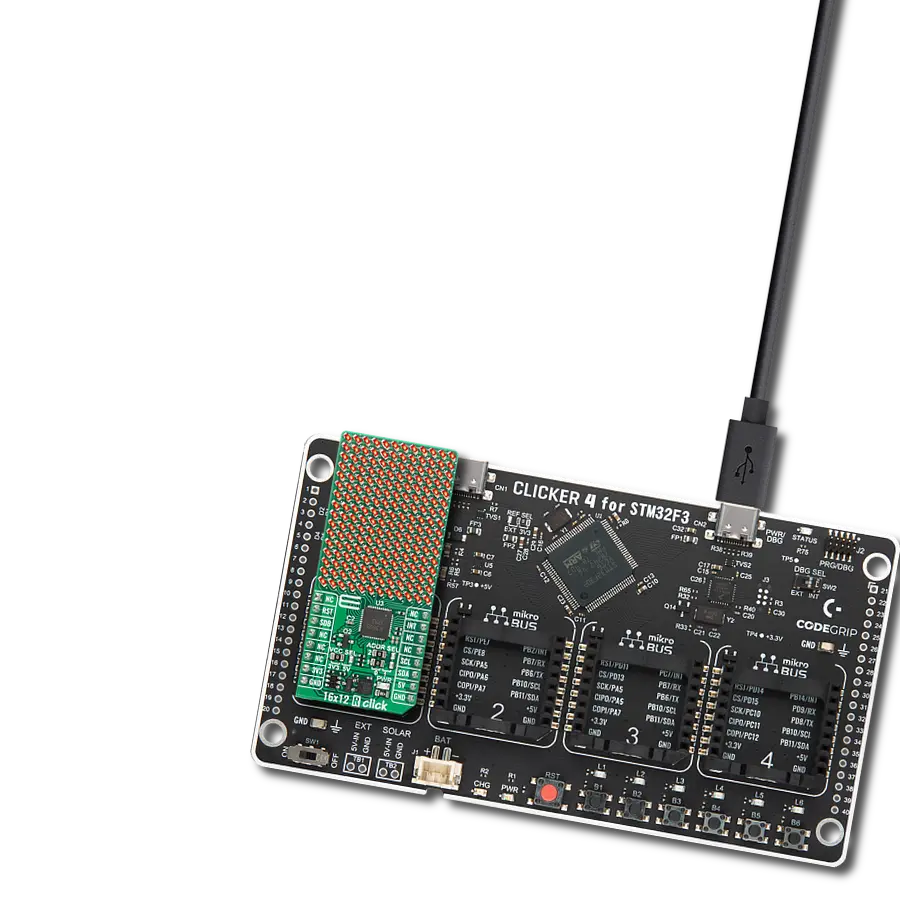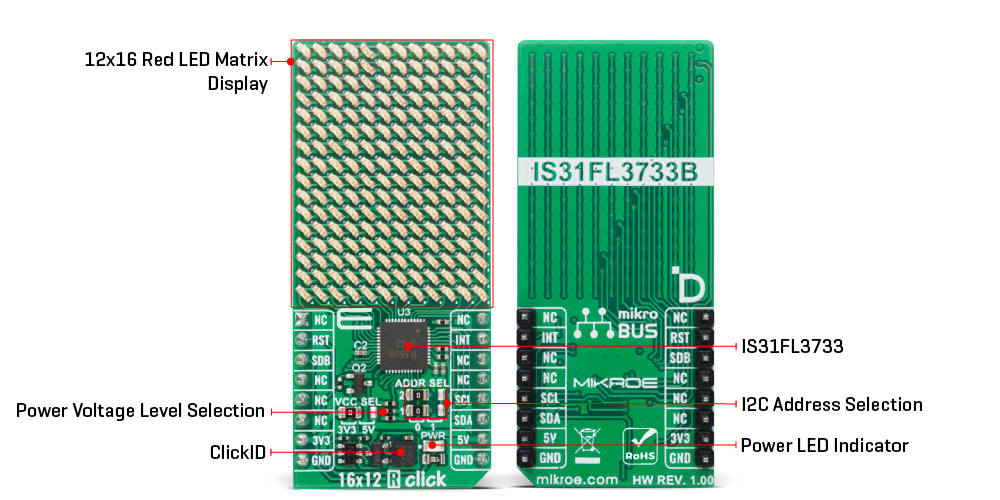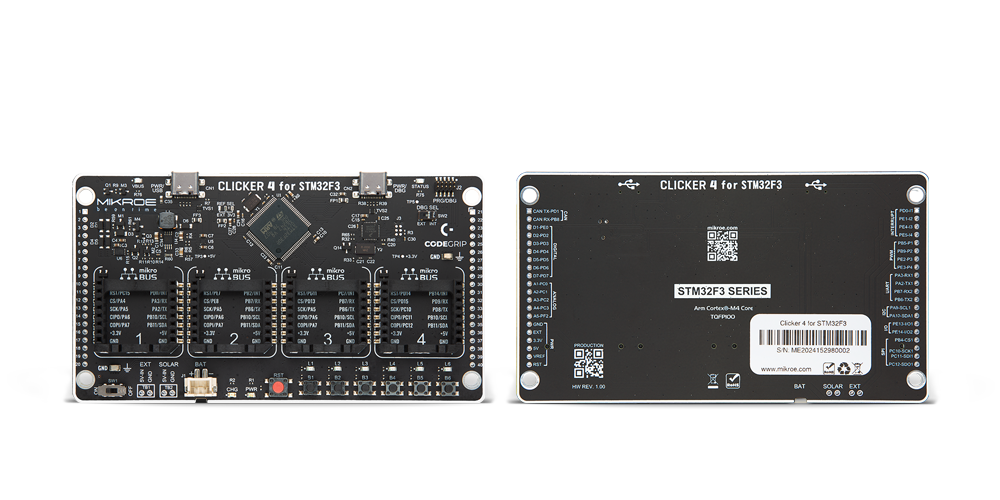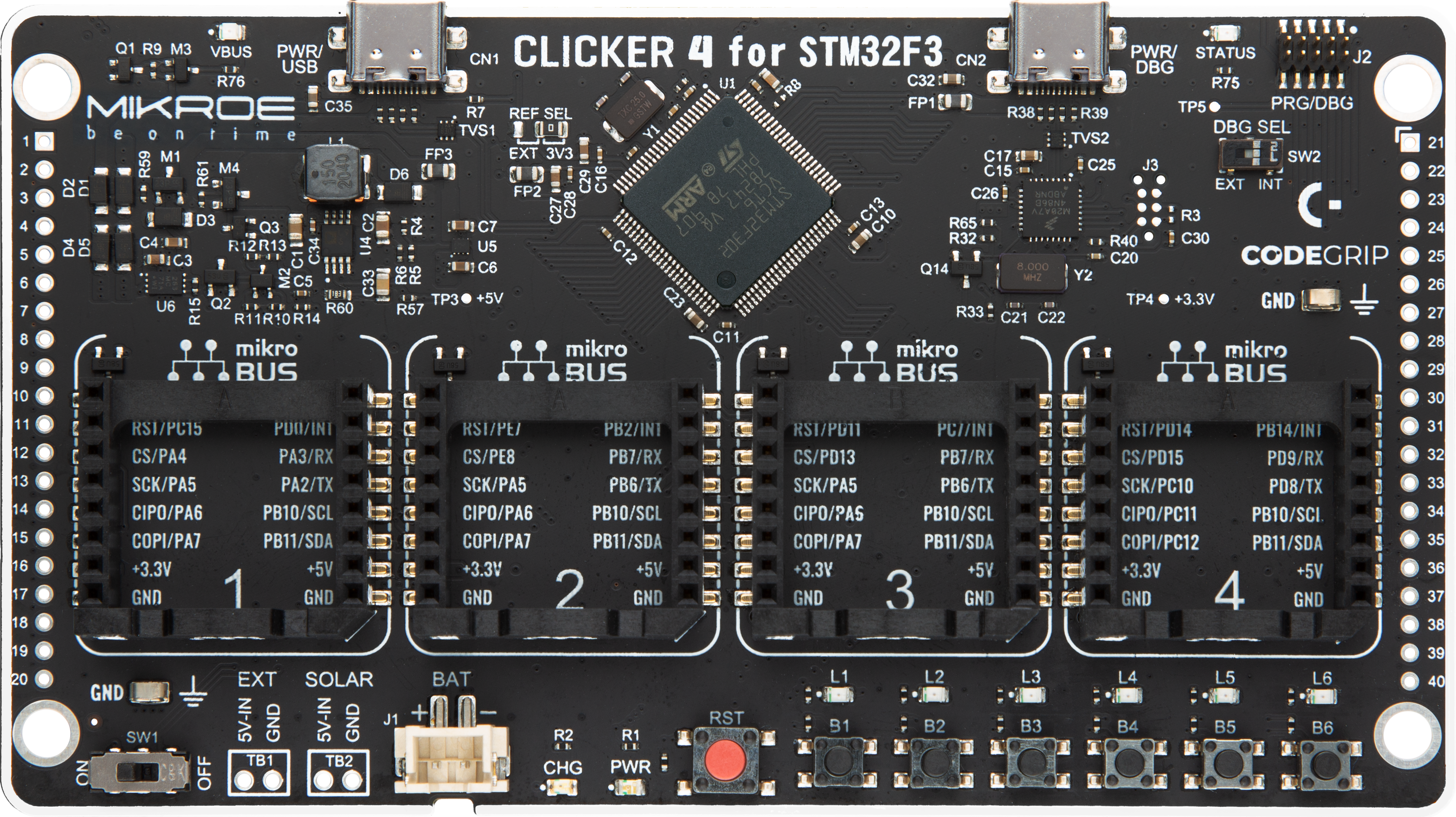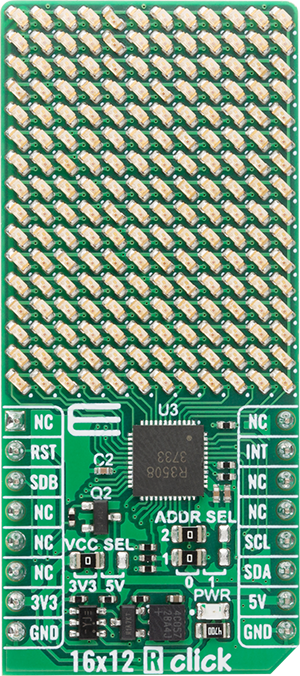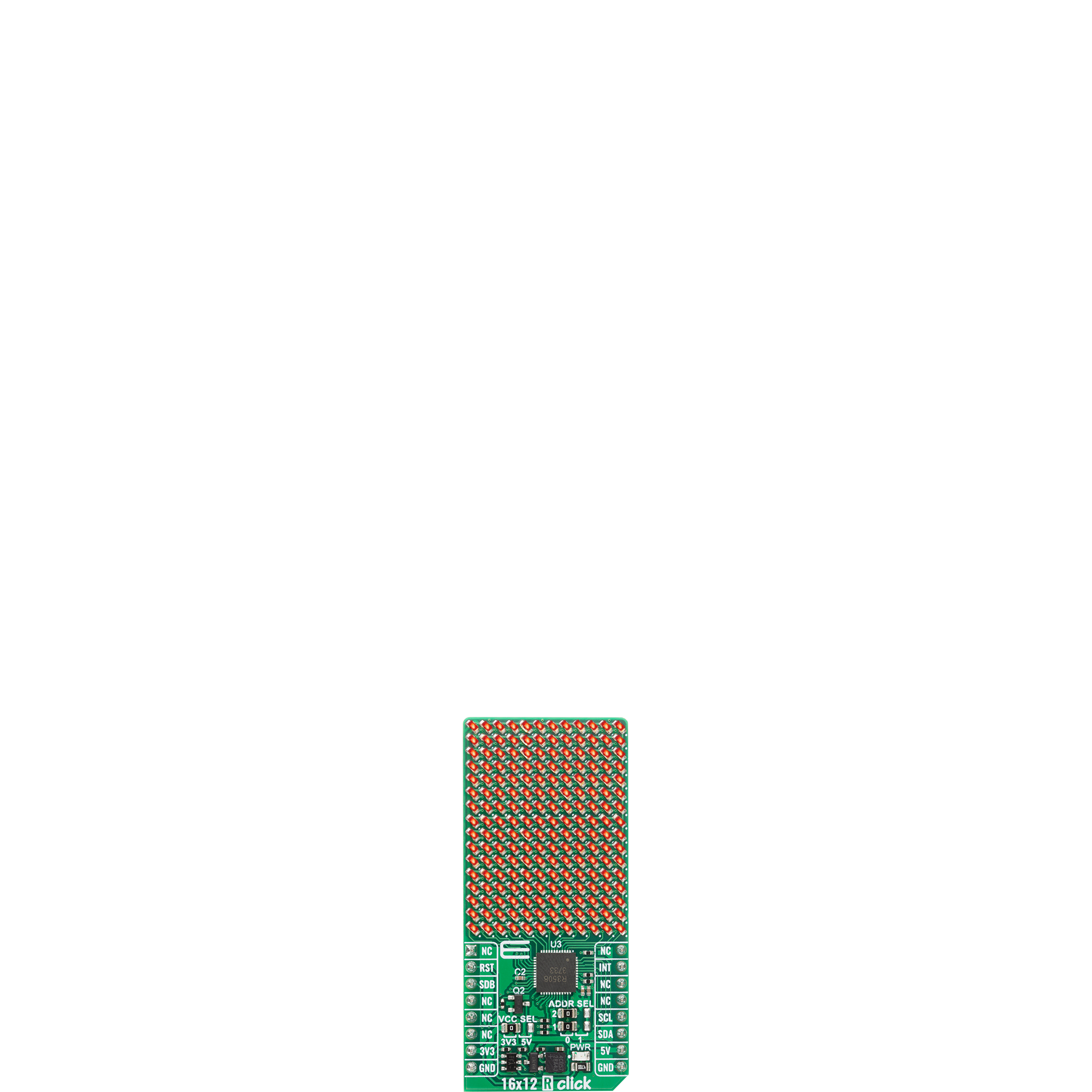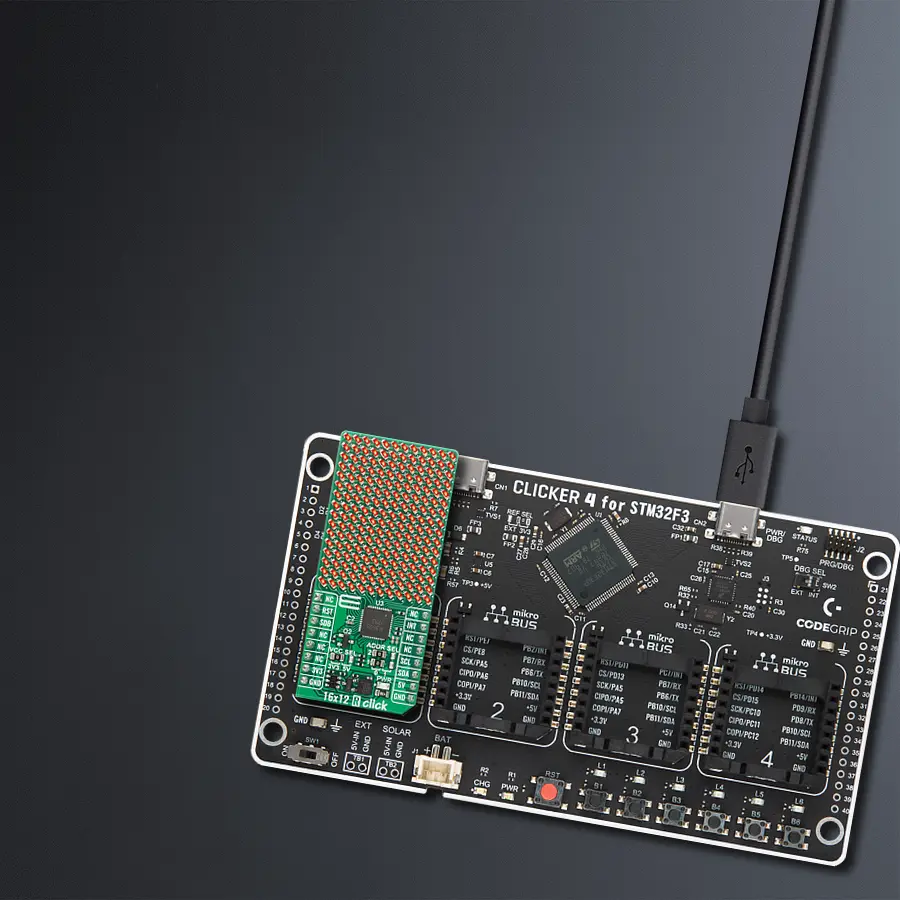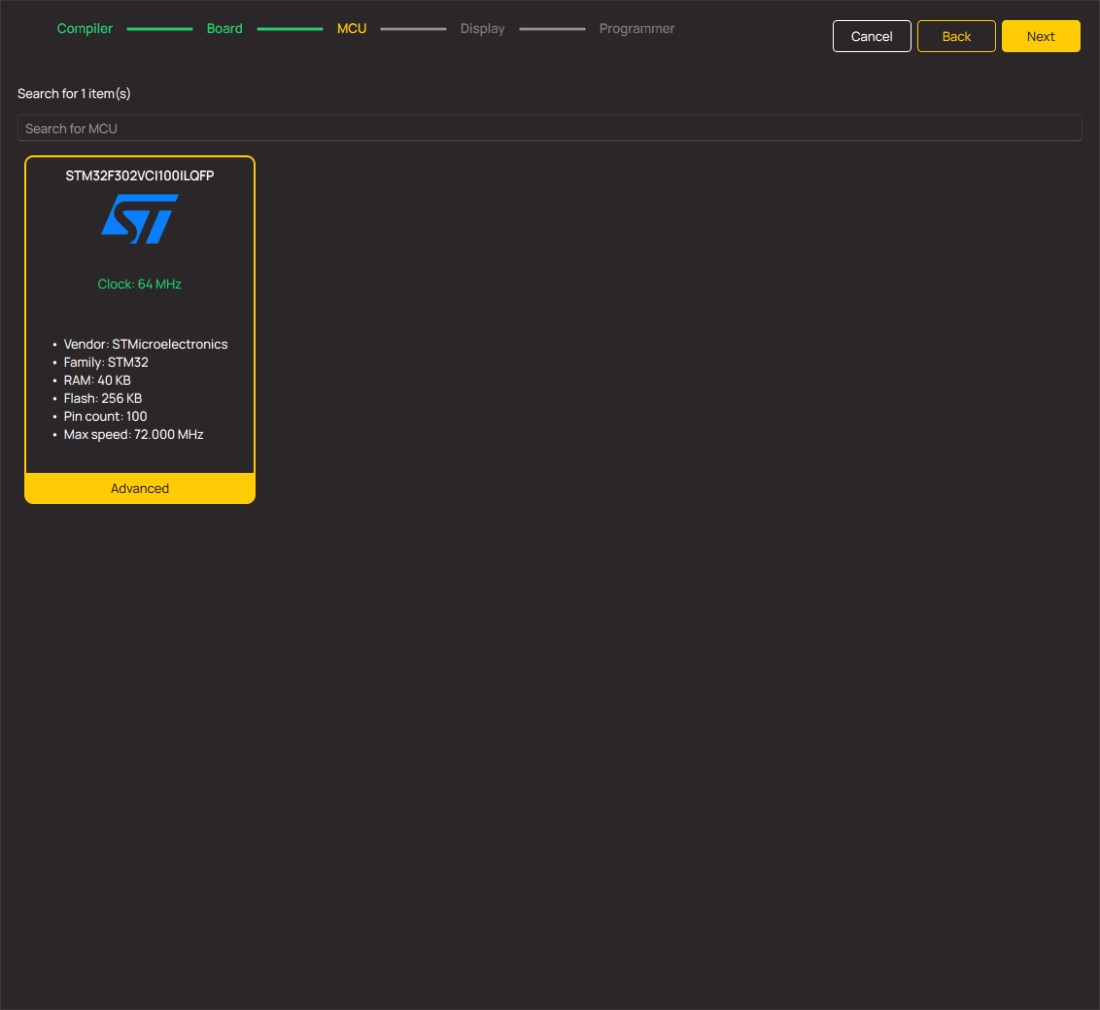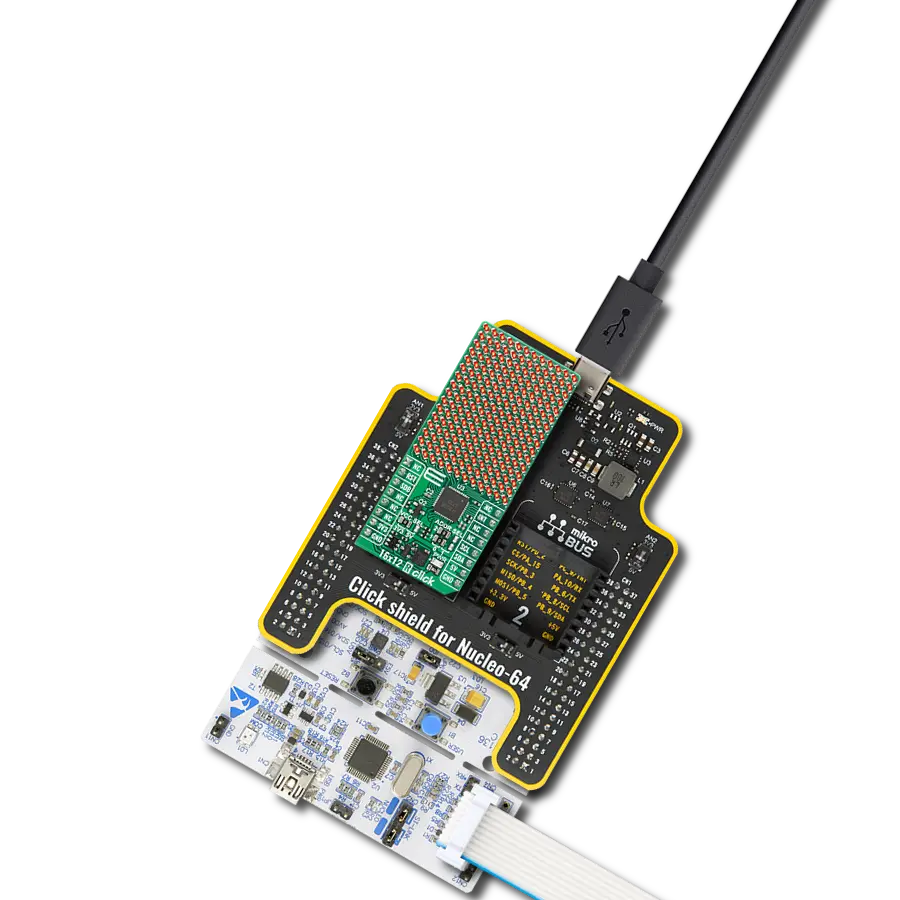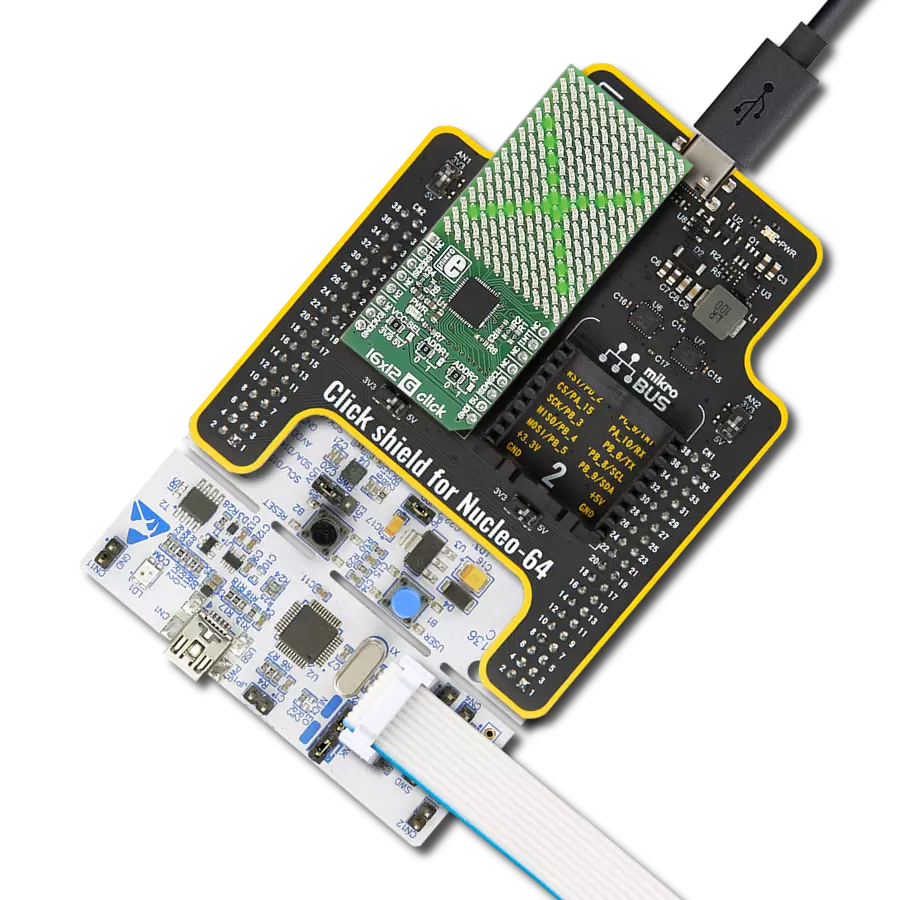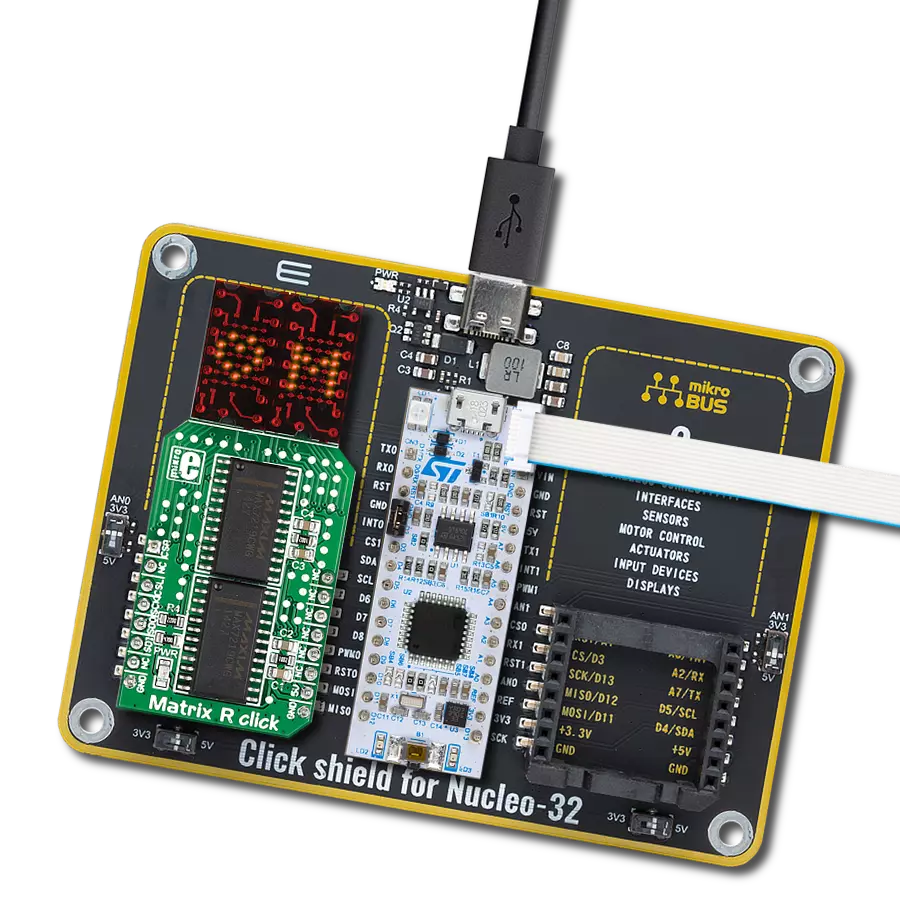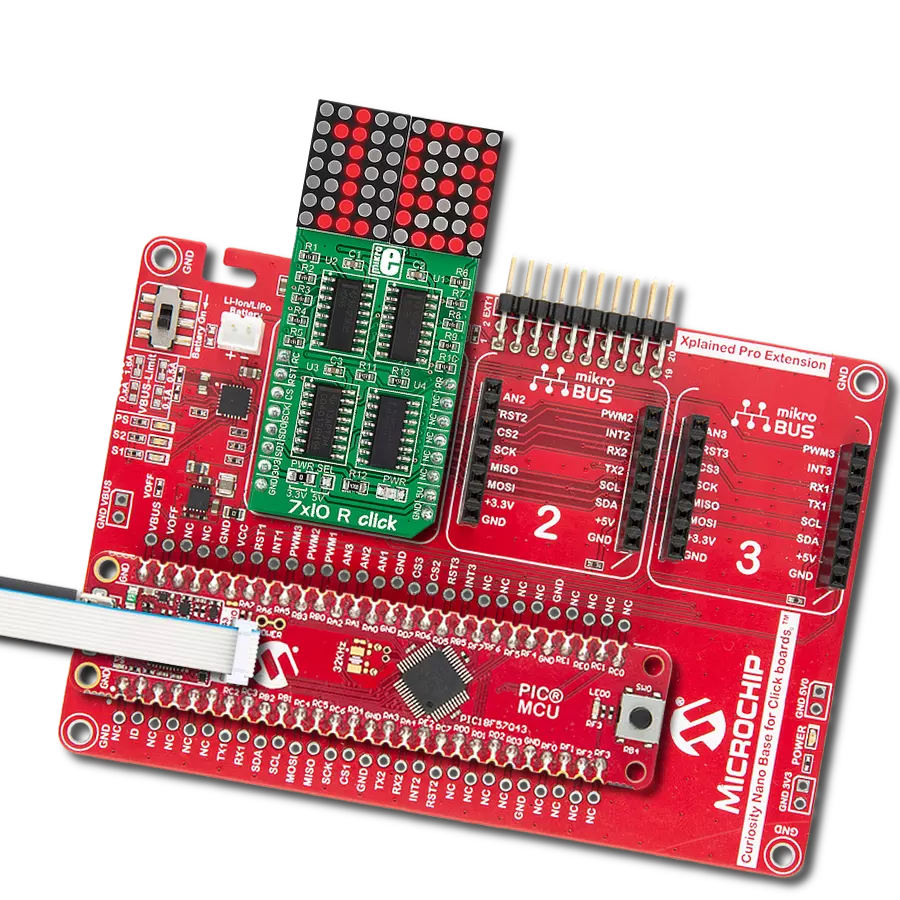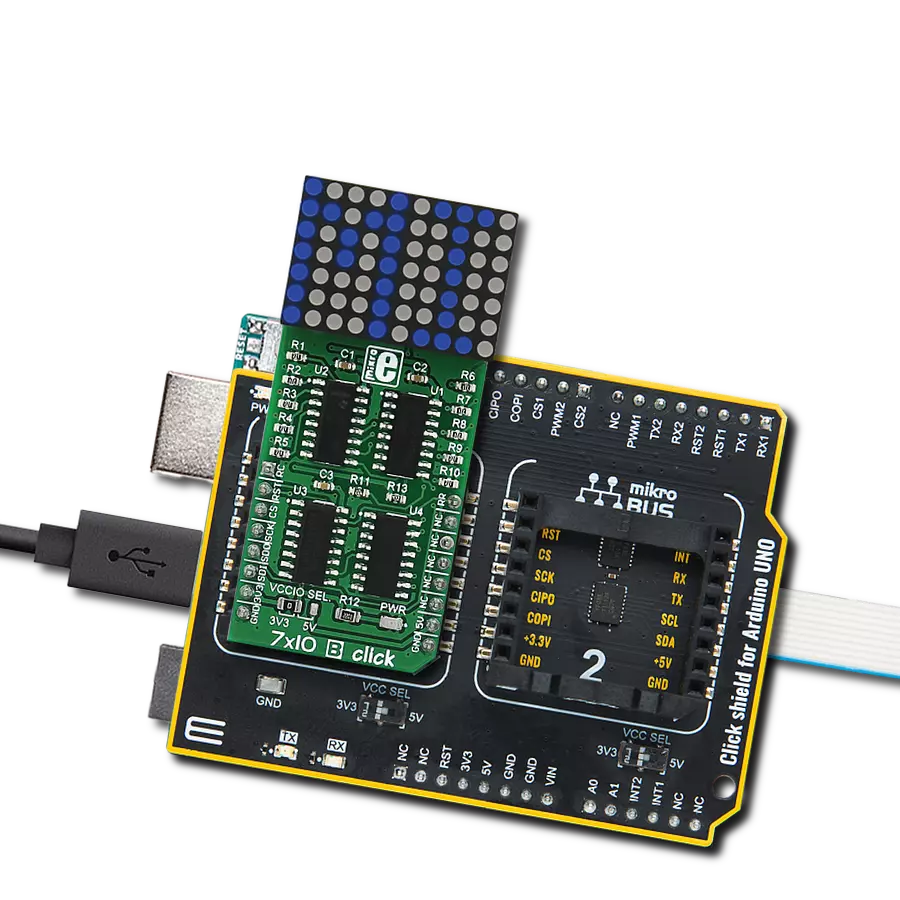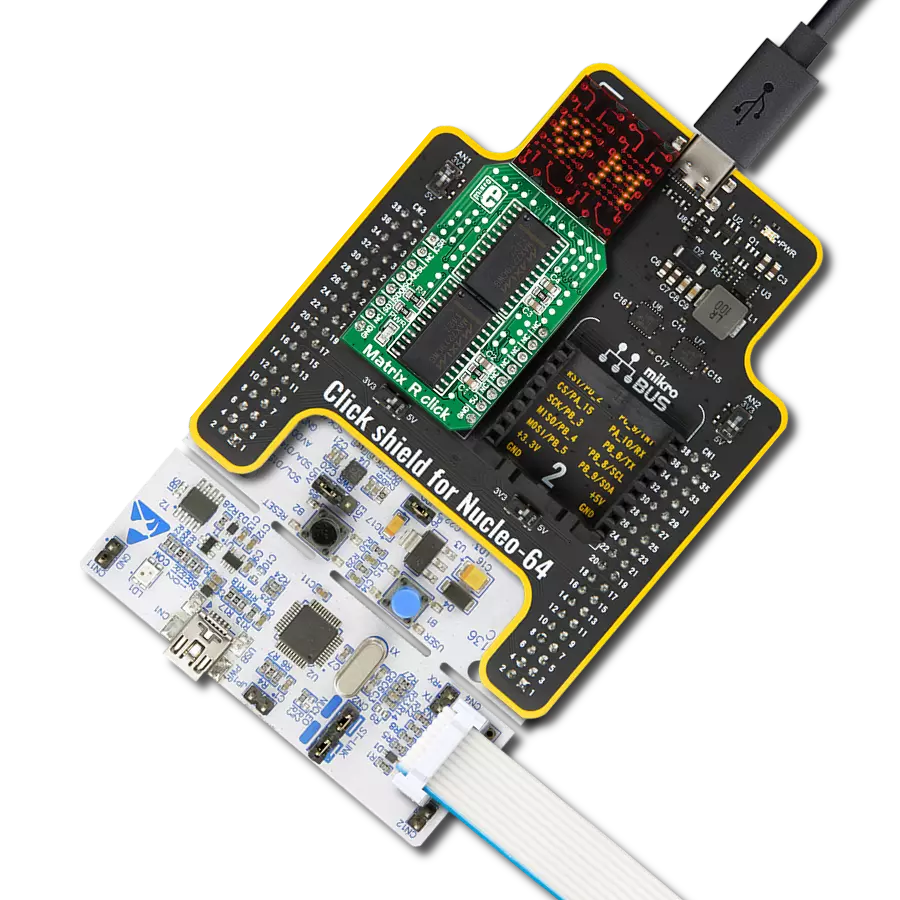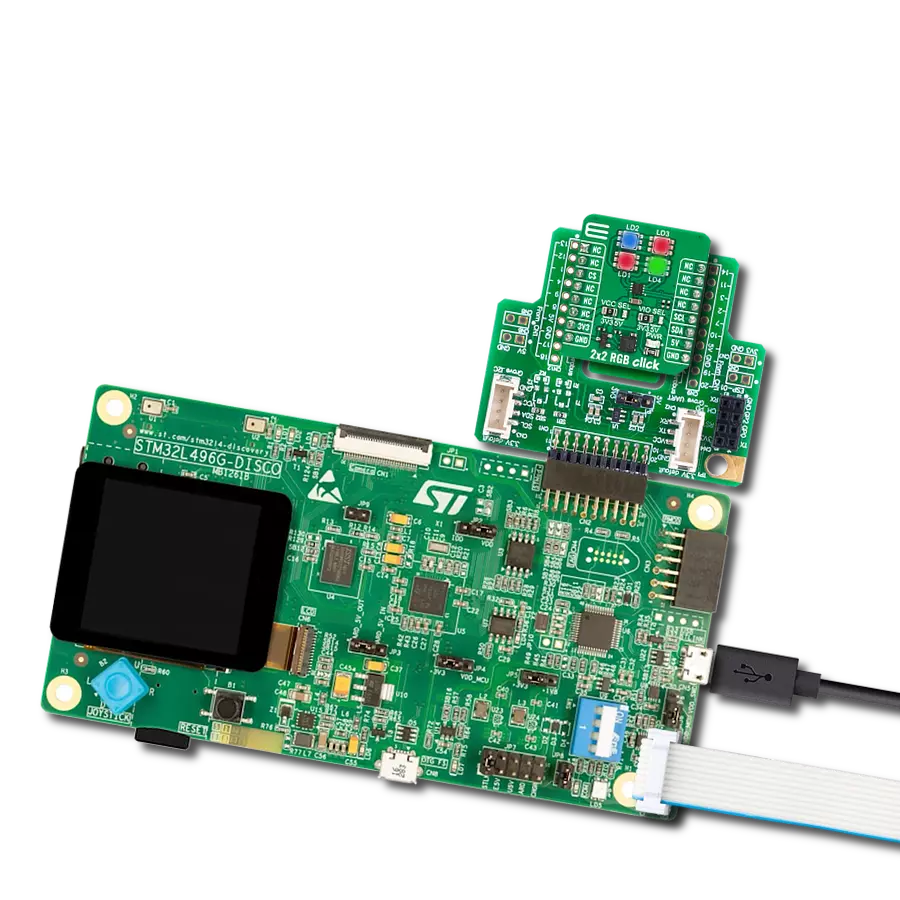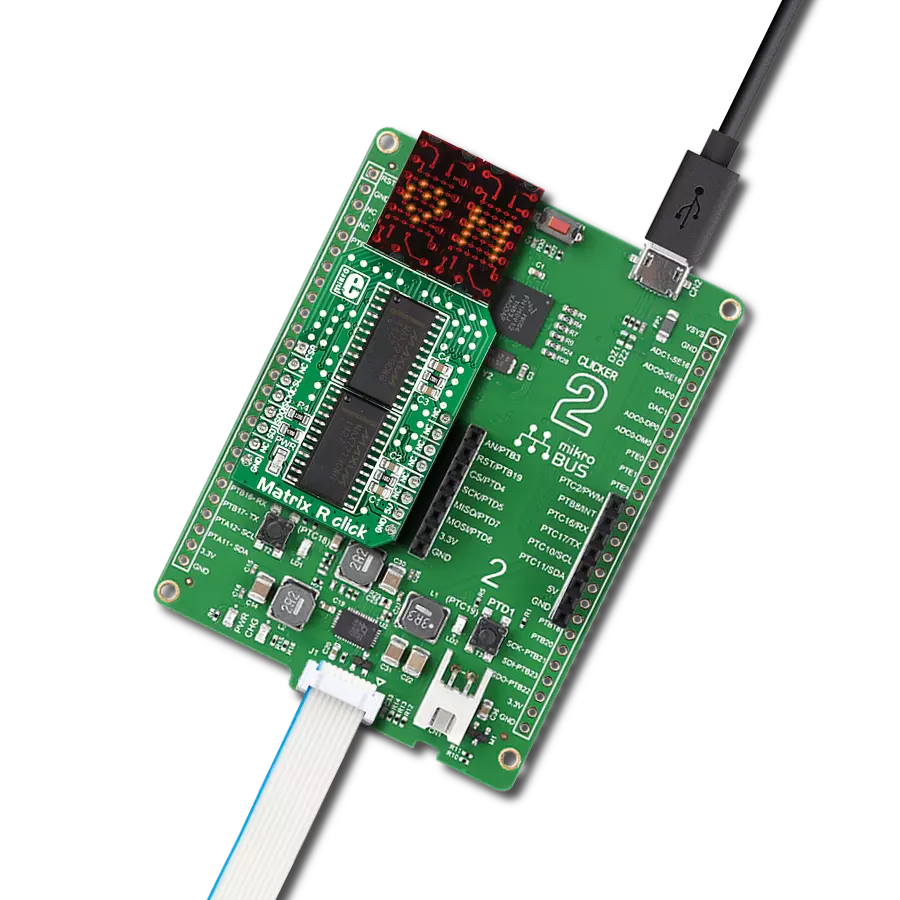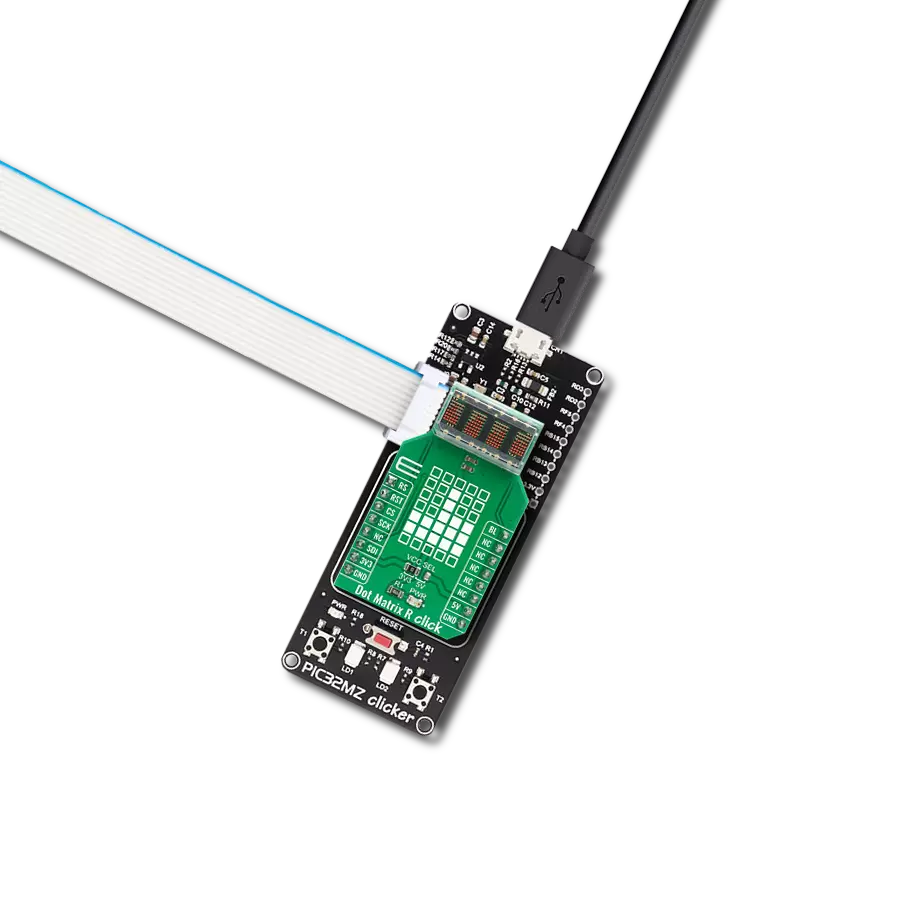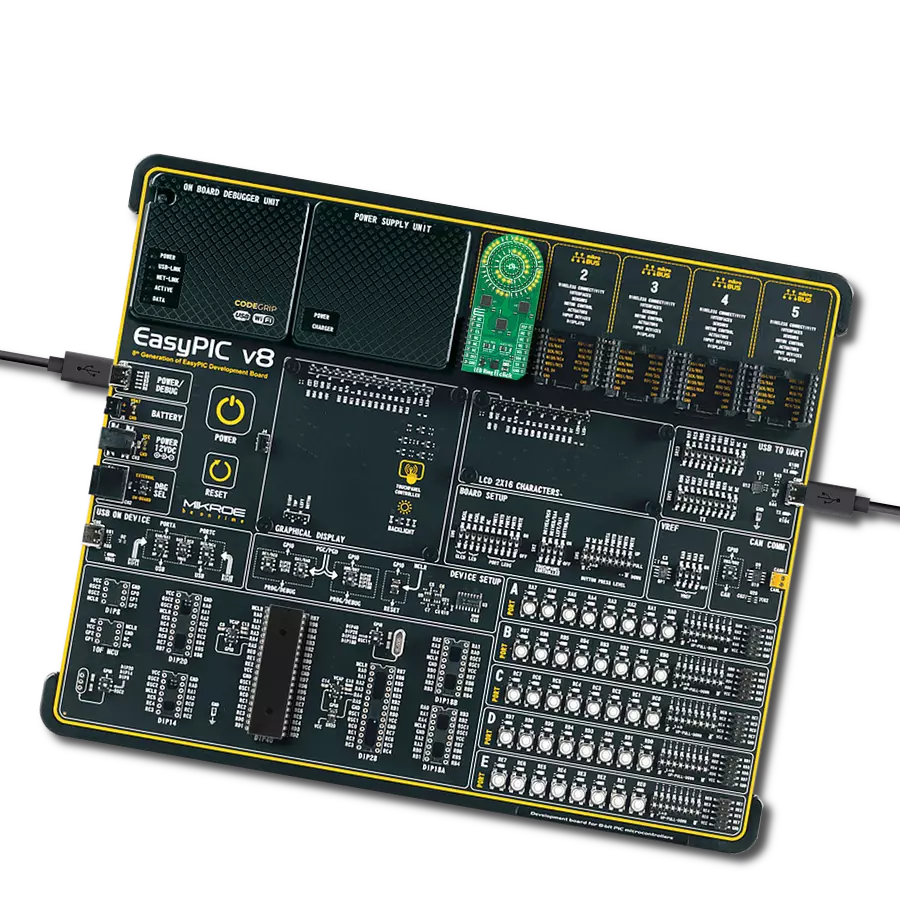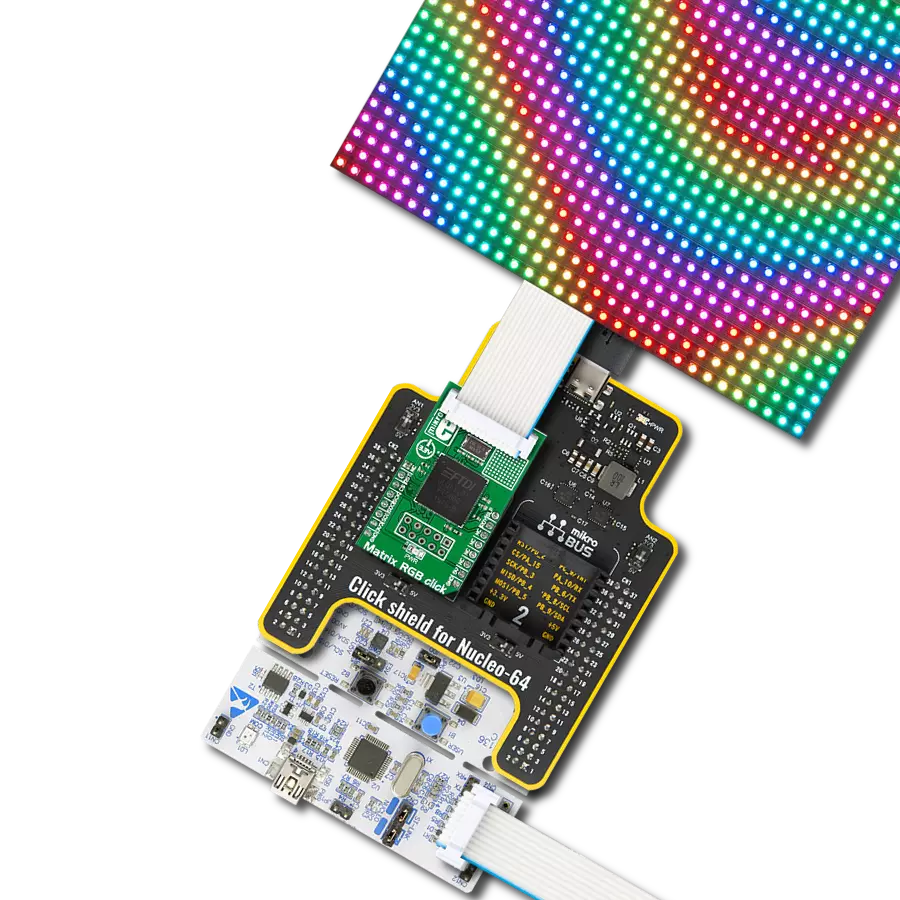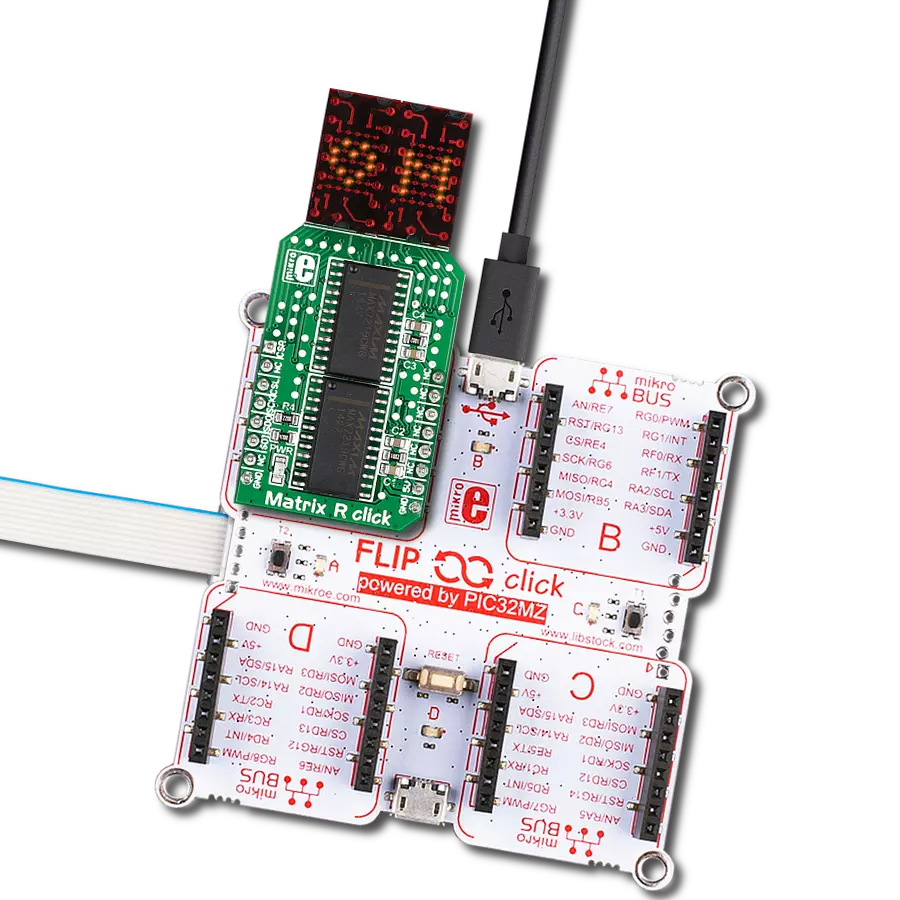Go-to solution for any application requiring precise and versatile red LED matrix management
A
A
Hardware Overview
How does it work?
16x12 R Click is based on the IS31FL3733 matrix driver from ISSI, a general-purpose 12×16 LEDs driver with a 1/12 cycle rate. This board integrates a 16x12 red LED display and allows full control of each LED for ON/OFF switching and brightness adjustment, making it an ideal solution for creating advanced visual indicators, status displays, and animation effects. Each of the 192 LEDs can be dimmed individually with 8-bit PWM data, providing 256 steps of linear dimming resolution for precise brightness control. Communication with the host MCU is achieved through the standard I2C 2-Wire interface, supporting Standard-Mode (100 kHz),
Fast-Mode (400 kHz), and Fast-Mode Plus (1 MHz) operation, ensuring compatibility and flexibility across a wide range of applications. The user can configure the I2C address via onboard SMD jumpers labeled ADDR SEL, which set the last three LSBs of the I2C address, allowing multiple devices to coexist on the same bus. In addition to the I2C communication pins, the IS31FL3733 also uses an INT pin for interrupt signaling, RST pin for chip reset, and an SDB pin for shutdown control, further enhancing functionality and power management. With its ability to manage large LED arrays, 16x12 R Click is suitable for applications
such as information panels, event counters, gaming devices, audio spectrum displays, notification systems, and other embedded solutions requiring detailed LED matrix control. This Click board™ can operate with either 3.3V or 5V logic voltage levels selected via the VCC SEL jumper. This way, both 3.3V and 5V capable MCUs can use the communication lines properly. Also, this Click board™ comes equipped with a library containing easy-to-use functions and an example code that can be used as a reference for further development.
Features overview
Development board
Clicker 4 for STM32F3 is a compact development board designed as a complete solution, you can use it to quickly build your own gadgets with unique functionalities. Featuring a STM32F302VCT6, four mikroBUS™ sockets for Click boards™ connectivity, power managment, and more, it represents a perfect solution for the rapid development of many different types of applications. At its core, there is a STM32F302VCT6 MCU, a powerful microcontroller by STMicroelectronics, based on the high-
performance Arm® Cortex®-M4 32-bit processor core operating at up to 168 MHz frequency. It provides sufficient processing power for the most demanding tasks, allowing Clicker 4 to adapt to any specific application requirements. Besides two 1x20 pin headers, four improved mikroBUS™ sockets represent the most distinctive connectivity feature, allowing access to a huge base of Click boards™, growing on a daily basis. Each section of Clicker 4 is clearly marked, offering an intuitive and clean interface. This makes working with the development
board much simpler and thus, faster. The usability of Clicker 4 doesn’t end with its ability to accelerate the prototyping and application development stages: it is designed as a complete solution which can be implemented directly into any project, with no additional hardware modifications required. Four mounting holes [4.2mm/0.165”] at all four corners allow simple installation by using mounting screws. For most applications, a nice stylish casing is all that is needed to turn the Clicker 4 development board into a fully functional, custom design.
Microcontroller Overview
MCU Card / MCU
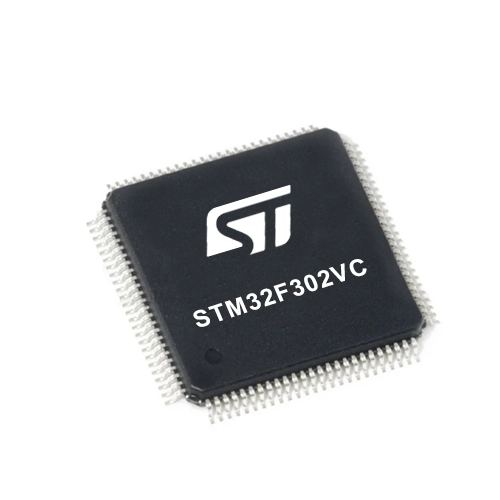
Architecture
ARM Cortex-M4
MCU Memory (KB)
256
Silicon Vendor
STMicroelectronics
Pin count
100
RAM (Bytes)
40960
Used MCU Pins
mikroBUS™ mapper
Take a closer look
Click board™ Schematic
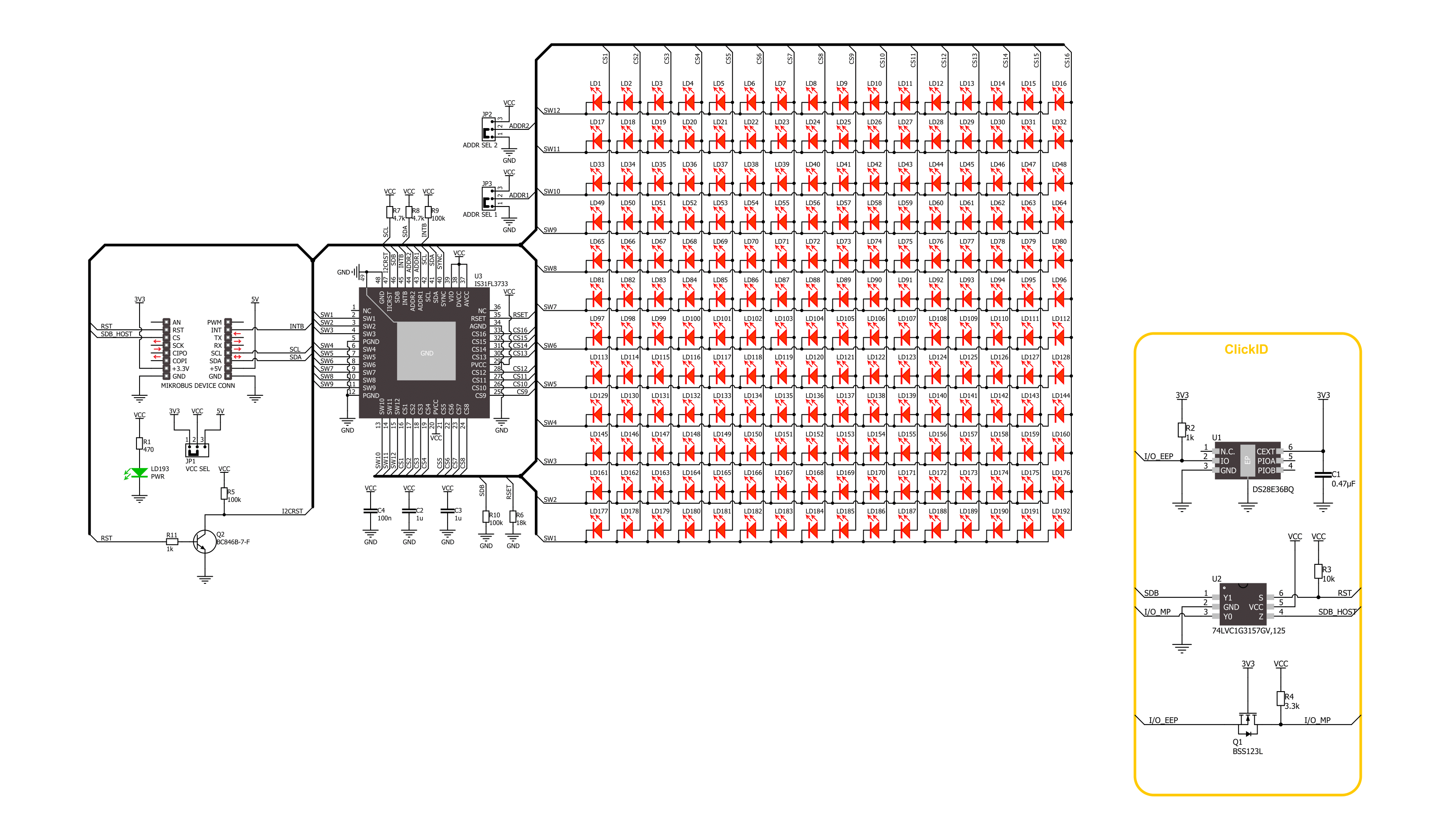
Step by step
Project assembly
Software Support
Library Description
16x12 R Click demo application is developed using the NECTO Studio, ensuring compatibility with mikroSDK's open-source libraries and tools. Designed for plug-and-play implementation and testing, the demo is fully compatible with all development, starter, and mikromedia boards featuring a mikroBUS™ socket.
Example Description
This example demonstrates the usage of the 16x12 R Click board which features a high-brightness red LED matrix display. It displays characters, rotates them in different orientations, prints a scrolling string, and renders a graphical image (MIKROE logo).
Key functions:
c16x12r_cfg_setup- This function initializes Click configuration structure to initial values.c16x12r_init- This function initializes all necessary pins and peripherals used for this Click board.c16x12r_default_cfg- This function executes a default configuration of 16x12 R Click board.c16x12r_write_char- This function writes a single ASCII character to the display.c16x12r_write_string- This function scrolls a null-terminated ASCII string across the display.c16x12r_draw_picture- This function draws a picture on the display from a 12-column buffer.
Application Init
Initializes the logger and the Click board and sets the default configuration.
Application Task
Displays single characters and a string in multiple rotations, followed by drawing and inverting the MIKROE logo image.
Open Source
Code example
The complete application code and a ready-to-use project are available through the NECTO Studio Package Manager for direct installation in the NECTO Studio. The application code can also be found on the MIKROE GitHub account.
/*!
* @file main.c
* @brief 16x12 R Click example
*
* # Description
* This example demonstrates the usage of the 16x12 R Click board which features a high-brightness
* red LED matrix display. It displays characters, rotates them in different orientations,
* prints a scrolling string, and renders a graphical image (MIKROE logo).
*
* The demo application is composed of two sections :
*
* ## Application Init
* Initializes the logger and the Click board and sets the default configuration.
*
* ## Application Task
* Displays single characters and a string in multiple rotations, followed by
* drawing and inverting the MIKROE logo image.
*
* @author Stefan Filipovic
*
*/
#include "board.h"
#include "log.h"
#include "c16x12r.h"
#include "c16x12r_resources.h"
static c16x12r_t c16x12r;
static log_t logger;
void application_init ( void )
{
log_cfg_t log_cfg; /**< Logger config object. */
c16x12r_cfg_t c16x12r_cfg; /**< Click config object. */
/**
* Logger initialization.
* Default baud rate: 115200
* Default log level: LOG_LEVEL_DEBUG
* @note If USB_UART_RX and USB_UART_TX
* are defined as HAL_PIN_NC, you will
* need to define them manually for log to work.
* See @b LOG_MAP_USB_UART macro definition for detailed explanation.
*/
LOG_MAP_USB_UART( log_cfg );
log_init( &logger, &log_cfg );
log_info( &logger, " Application Init " );
// Click initialization.
c16x12r_cfg_setup( &c16x12r_cfg );
C16X12R_MAP_MIKROBUS( c16x12r_cfg, MIKROBUS_1 );
if ( I2C_MASTER_ERROR == c16x12r_init( &c16x12r, &c16x12r_cfg ) )
{
log_error( &logger, " Communication init." );
for ( ; ; );
}
if ( C16X12R_ERROR == c16x12r_default_cfg ( &c16x12r ) )
{
log_error( &logger, " Default configuration." );
for ( ; ; );
}
log_info( &logger, " Application Task " );
}
void application_task ( void )
{
log_printf( &logger, " Writing digits\r\n\n" );
c16x12r.text_rotation = C16X12R_ROTATION_H_0;
for ( uint8_t digit = '0'; digit <= '9'; digit++ )
{
c16x12r_write_char ( &c16x12r, digit );
Delay_ms ( 500 );
}
log_printf( &logger, " Rotating char\r\n\n" );
c16x12r.text_rotation = C16X12R_ROTATION_H_0;
c16x12r_write_char ( &c16x12r, 'R' );
Delay_ms ( 500 );
c16x12r.text_rotation = C16X12R_ROTATION_H_180;
c16x12r_write_char ( &c16x12r, 'R' );
Delay_ms ( 500 );
c16x12r.text_rotation = C16X12R_ROTATION_V_0;
c16x12r_write_char ( &c16x12r, 'R' );
Delay_ms ( 500 );
c16x12r.text_rotation = C16X12R_ROTATION_V_180;
c16x12r_write_char ( &c16x12r, 'R' );
Delay_ms ( 500 );
c16x12r.text_rotation = C16X12R_ROTATION_H_0;
c16x12r_write_char ( &c16x12r, 'R' );
Delay_ms ( 500 );
log_printf( &logger, " Writing text\r\n\n" );
c16x12r.text_rotation = C16X12R_ROTATION_H_0;
c16x12r_write_string ( &c16x12r, "MIKROE - 16x12 R Click", 50 );
Delay_ms ( 1000 );
log_printf( &logger, " Writing text\r\n\n" );
c16x12r.text_rotation = C16X12R_ROTATION_H_180;
c16x12r_write_string ( &c16x12r, "MIKROE - 16x12 R Click", 50 );
Delay_ms ( 1000 );
log_printf( &logger, " Writing text\r\n\n" );
c16x12r.text_rotation = C16X12R_ROTATION_V_0;
c16x12r_write_string ( &c16x12r, "MIKROE - 16x12 R Click", 50 );
Delay_ms ( 1000 );
log_printf( &logger, " Writing text\r\n\n" );
c16x12r.text_rotation = C16X12R_ROTATION_V_180;
c16x12r_write_string ( &c16x12r, "MIKROE - 16x12 R Click", 50 );
Delay_ms ( 1000 );
log_printf( &logger, " Drawing MIKROE logo\r\n\n" );
c16x12r_draw_picture ( &c16x12r, c16x12r_img_mikroe );
Delay_ms ( 1000 );
Delay_ms ( 1000 );
log_printf( &logger, " Drawing inverted MIKROE logo\r\n\n" );
c16x12r_draw_picture ( &c16x12r, c16x12r_img_mikroe_inv );
Delay_ms ( 1000 );
Delay_ms ( 1000 );
}
int main ( void )
{
/* Do not remove this line or clock might not be set correctly. */
#ifdef PREINIT_SUPPORTED
preinit();
#endif
application_init( );
for ( ; ; )
{
application_task( );
}
return 0;
}
// ------------------------------------------------------------------------ END
Additional Support
Resources
Category:LED Matrix
